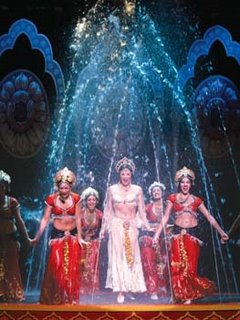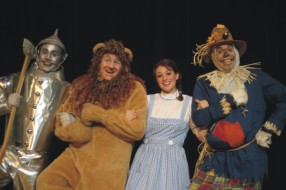 I desperately wanted to go home at intermission on opening night of Acme Theater Company’s production of Carlo Goldoni’s “The Venetian Twins,” on the Davis Art Center outdoor stage.
I desperately wanted to go home at intermission on opening night of Acme Theater Company’s production of Carlo Goldoni’s “The Venetian Twins,” on the Davis Art Center outdoor stage.My desire to leave had nothing to do with the delightful slapstick comedy that was going on on stage, and everything to do with the fact that it was very, very cold in the outdoor amphitheater and I had not thought to bring warm enough clothing.
“The Venetian Twins” continues through Monday evening and while I encourage everyone to go and see this sparkling free production, I also advise warm clothes and a blanket. A thermos of hot coffee might not be such a bad idea either.
The Acme adaptation of Goldoni’s “twin play” is a rather loose one, explains director David Burmester. Before the cast got the script, he had already decided to add a second set of twins to the original story. He notes that “The script I handed the cast on the first day of rehearsal was a result of a severe working over of Goldoni, interjecting a number of modern turns of phrase and, of course, the new set of twins.”
Once the cast has the script they being to “riff on it.” “It never stops,” says Burmester. “Sometimes a great gag is the result of a serendipitous accident.”
Seeing these young actors on the stage, one cannot help but know that they are just having the time of their lives. Anyone who might be a devotee of the original Goldoni play might not quite recognize it in this form, but if the end justifies the means, the playwright himself would get a chuckle out of it. It’s more like the Marx Brothers and the Three Stooges go romping through the 18th century.
The story is not unfamiliar. A very funny flip chart lecture at the beginning by the character of Brighella (Zack Leuchars) gives everyone an overview of the lives of the characters to this point, in order to avoid having to do a lot of expository dialog throughout the play itself.
As for the story unfolding on stage, it tells the tale of long-separated identical twin brothers, who arrive in Verona on the same day, unbeknownst to each other. One has come to meet his wife-to-be (a marriage arranged by the Widow Balanzoni (Lisa Voelker); the other is meeting his fiancée, who has run away from her family to join him. Naturally all sorts of misunderstandings follow when jewels, money, and declarations of love are passed back and forth among the wrong people. There are sword fights, fistfights, seduction attempts, flirtations with incest, battles with the law and the endless confusions of identity.
Playing the twins, Zanetto (the rich, but dim-witted one) and Tonino (the poor but gentlemanly and honorable one) is Dara Yazdani in a role which is ready-made for him. With his long, lanky body which sometimes appears to have no bones, and his ability to get the most out of facial expressions, he was able to make Zanetto and Tonino completely different people in the blink of an eye. Zanetto’s last scene in the play was hilarious.
Madelyn Ligtenberg (Rosaura) and Fiona Lakeland (Beatrice) are the confused would-be fiancées to the twins.
Anthony Pinto has the plum role of Pancrazio, in love with Rosaura, to whom Zanetto is betrothed. Pinto is so talented he can play a wide range of characters, but he really shines at being the bad guy.
Tatiana Ray is Colombina, the brazen, man-crazed maid to Rosaura, who gets away with murder in the house because she knows Rosaura’s mother’s (Lisa Voelker) long-held secret.
Victoria Gimpelevich is Arlecchinetta, companion to Beatrice, masquerading as a man to act as her mistress’s protector. John Ramos is Arlecchino, her long-lost twin brother.
Josh van Eyken is the foppish Lelio and J.R. Yancher is Tonino’s confused pal Florindo, both hoping to win the hand of Beatrice away from Tonino.
There are several fun dance numbers (particularly one by porters Ernie Hernandez and Isaac Aldous) which pop up from time to time, and which do credit to choreographers Cami Beaumont and Laura Flanigan.
Josh van Eyken, J.R. Yanker and Dara Yazdani are credited with sword fight choreography and deserve high marks.
The first act of this production seems to run a little long, but it may have been because the wind had picked up again, but the second act zips by. Acme has again presented a delightful comedy which leave the audience laughing after the cast has taken its bows.
Don’t let the possibility of a cold evening keep you from this performance. But do remember to plan accordingly to enhance your enjoyment of the fun on stage.








